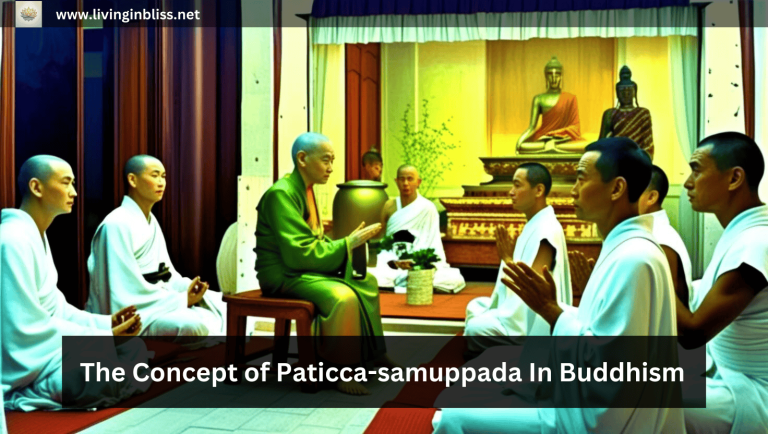The Pali Canon | The Foundation of Theravada Buddhism

What is the Pali Canon?
Pali Canon, sometimes called Tipitaka, is a collection of ancient Buddhist texts. Most importantly, Theravada Buddhism is based on them.
Written in the ancient Pali language, Tipitaka is the most intensive and reliable account of Buddha’s teachings. Spiritual knowledge, meditation, and moral behaviour are all involved in this anthology.
Education, discipline, and philosophical debate make “three curves,” which differ in three divisions. Because it provides intensive insight into reaching Nirvana, the Pali Canon is important for Buddhist studies and practice today. The lessons continue to improve people’s intelligence, compassion, and kindness.
Teachings of the Pali Canon
The nature of life, the path of freedom, and the formation of moral character are all included in the doctrine. Important topics include the noble eight times the road, four great truths, and three existence marks: inequality, pain, and non-self. In order to obtain information, this doctrine emphasizes the importance of knowledge, compassion, and mindfulness.
Going through the teachings of the Pali Canon..
Although reading the Pali Canon might change one’s life, beginners may find its vastness and complexity difficult. It covers more than 40 volumes of modern translations and covers a variety of genres, including philosophical studies, poetry, and lectures.
The Sutta Pitaka, which includes the Dhammapada, is a compilation of the Buddha’s sayings. The monks frequently suggest them as the starting texts for novices, even in present times.
Interpreting this Masterpiece
To truly understand the Pali Canon, it is important to know its historical and cultural background. The narration, with many metaphors and symbols, tells us the philosophy and spiritual traditions behind ancient India.
This can make it challenging to grasp the full meaning of the Buddha’s teachings without some background knowledge.

To facilitate their interpretation, academics and doctors often consulted comments, such as those written by the famous Theravadian in the fifth century by Monk Buddhagesa. These comments provide perfect interpretations and insight into the importance of important roads. For contemporary doctors, relevant interpretation is necessary to maintain knowledge of reach and praise.
The Place Where The Pali Canon is Belonged in Buddhism
Being considered the most real account of Buddha’s teachings, Tipitaka provides a deeper guide for both tendon and monastery exercises. It is a useful tool for understanding ancient Indian philosophy, morality, and culture, as well as its religious significance.
The Pali Canon’s Place in Theravada Buddhism
Countries practising Theravada Buddhism (Sri Lanka, Thailand, Myanmar, and Laos) follow Tipitaka. The influence of the canon shapes the meditation methods, rituals, and morality of Buddhism.
The Three Baskets of the Pali Canon
The 3 main baskets, or the volumes in Tripitaka, include:
The Vinaya Piṭaka (The Basket of Discipline): This volume describes the rules when living in a temple for monks. For laypersons, this Pitaka mentions the norms for peaceful community living and moral behaviour.
The Sutta Piṭaka (The Basket of Discourses): More than 10,000 teachings, including the Buddha’s sermons and conversations with his students, are documented here. They include Majjhima Nikaya (Middle-Length Discourses), Digha Nikaya (Long Discourses), and Samyutta Nikaya (Connected Discourses).
The Abhidhamma Piṭaka (The Basket of Higher Teachings): This section includes an in-depth philosophical analysis of the Buddha’s teachings that explores the nature of reality and cognition. It is theoretical and is recommended to be more suitable for older philosophers and academics.
Historical Background Behind the Pali Canon

The First Buddhist Council, held shortly after the Buddha’s passing in the fifth century BCE, led to the creation of Tipitaka. The teachings had been passed orally for many generations until the first century BCE.
The teachings were finally recorded in writing during the reign of Sri Lankan King Walagamba. To preserve the Buddha’s wisdom through times of political and social stirs, monks carefully carved the knowledge on palm leaves.
A Buddhist’s Practice alongside Buddha’s Words in Tipitaka
The Pali Canon controls every Theravada Buddhist’s practice. While the Sutta Piṭaka encourages civilians to live a life of mindfulness and compassion, the Vinaya Piṭaka offers ethical guidelines for monks and nuns. In line with the ultimate objective of Nibbana (freedom), the teachings place a strong emphasis on meditation as a means of achieving inner serenity and insight.
Structure of the Pali Canon
The structure of the Pali Canon shows its comprehensive approach to spiritual instruction. Each of the three baskets is further broken down into little collections, chapters, and verses to help manage the massive volume of content. The Sutta Piṭaka consists of five Nikayas (collections), each of which addresses a certain audience and subject.
Tips to Use When Going Through the Pali Canon by Yourself
Patience and a solid plan can lead you to your goal of really understanding Tipitaka. For that,
1. Start with easy-to-read discourses or basic literature like the Dhammapada.
2. Use accurate translations that include easily understandable explanations.
3. Pay attention to particular areas (like mindfulness, compassion, etc) one at a time to get a thorough understanding.
4. Join study groups and ask experienced instructors for assistance with difficult sections.
5. Put the lessons into practice in your day-to-day life activities to get the benefit!
Most Frequently Asked Questions
1. What is the Pali Canon?
The Pali Canon or Tipiṭaka is the primary collection of early Buddhist texts in Pali. Up to this date, it serves as the layout for Theravada Buddhism.
2. Why is the Pali Canon important in Buddhism?
It is the most authoritative text in Theravada Buddhism and includes Buddha’s teachings. It serves as the framework for moral conduct, reflection, and meditation in Buddhism.

3. What are the main sections of the Pali Canon?
The three divisions are Abhidhamma Piṭaka (philosophical teachings), Sutta Piṭaka (Buddha discourses), and Vinaya Piṭaka (monastic norms).
4. How should someone approach to read the Pali Canon?
Start with shorter works, such as the Dhammapada, concentrating on important ideas. Use trustworthy translations with remarks, and ask informed people for advice.
5. What are the major texts included in the Pali Canon?
The Dhammapada, Sutta Nipata, Majjhima Nikaya, Digha Nikaya, and Vinaya rules are among the important writings.
6. How does the Pali Canon relate to Theravada Buddhism?
Theravada Buddhism’s traditions, practices, and teachings are all based on Tipitaka!
7. What is the history of the Pali Canon?
Tripitaka was written down in Sri Lanka in the first century BCE after the Buddha’s passing.
8. How can the teachings of the Pali Canon be applied in Buddhist practice?
They guide both lay people and monks towards mindfulness, meditation, moral behaviour, and the quest for enlightenment!
9. What are some tips for interpreting the Pali Canon?
Understand its historical and cultural background, use commentaries like those by Buddhaghosa, and focus on the deeper meanings beneath the symbolism.
10. How does the Pali Canon compare to other Buddhist scriptures?
It emphasizes early teachings and is unique to Theravada Buddhism.
Using subsequent philosophical and religious concepts, a group of monks founded Mahayana Buddhism later.
Final Thoughts on Tipitaka..
Remaining as the repository of Buddha’s own words, the Pali Canon is like a lighthouse for Buddhists who are seeking spiritual growth. Even though monks found it so long ago, we are fortunate enough to have these teachings still with us.

By understanding the Tipitaka’s structure, significance, and utility, we modern readers can interact with it in-depth. As Buddhists, it is our utmost duty to carry on and protect the Buddha’s teachings to remain a lasting legacy.






